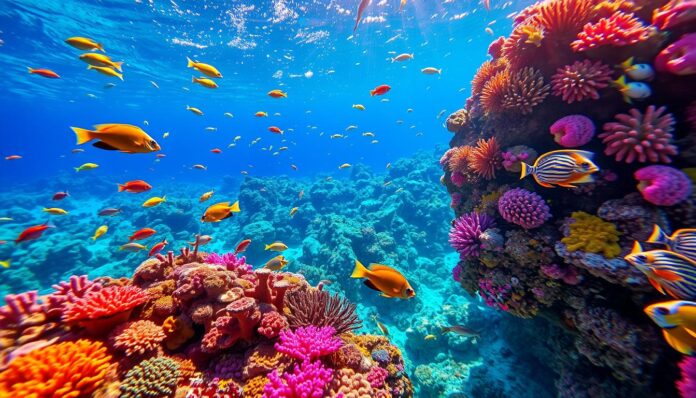| Best Time to Travel | December to April |
| What to Expect | Warm water, clear visibility, diverse marine life |
| Diving Conditions | Year-round, but best from December to April |
| Marine Life | Whale sharks, thresher sharks, turtles, sharks, dolphins, fish |
Are you ready to explore the most spectacular underwater paradise on Earth? The Philippines offers a diving experience unlike any other in the world.
Nestled in the heart of the Coral Triangle, the Philippines is a diving destination like no other. It has over 7,641 islands and more than 400 species of coral. This tropical archipelago promises divers an unparalleled marine ecosystem waiting to be discovered.
Scuba diving in the Philippines isn’t just a sport – it’s a gateway to one of the most biodiverse marine environments on the planet. From the legendary Tubbataha Reefs Natural Park to the mesmerizing sardine runs of Moalboal, each dive site tells a unique story of marine life and underwater wonder.
Key Takeaways – Scuba Diving in The Philippines
- Access to over 7,000 islands with unique diving experiences
- Home to the world’s most diverse marine ecosystems
- Exceptional visibility often exceeding 30 meters
- Opportunities to encounter rare marine species
- UNESCO World Heritage marine sites
- Growing dive tourism market with exciting opportunities
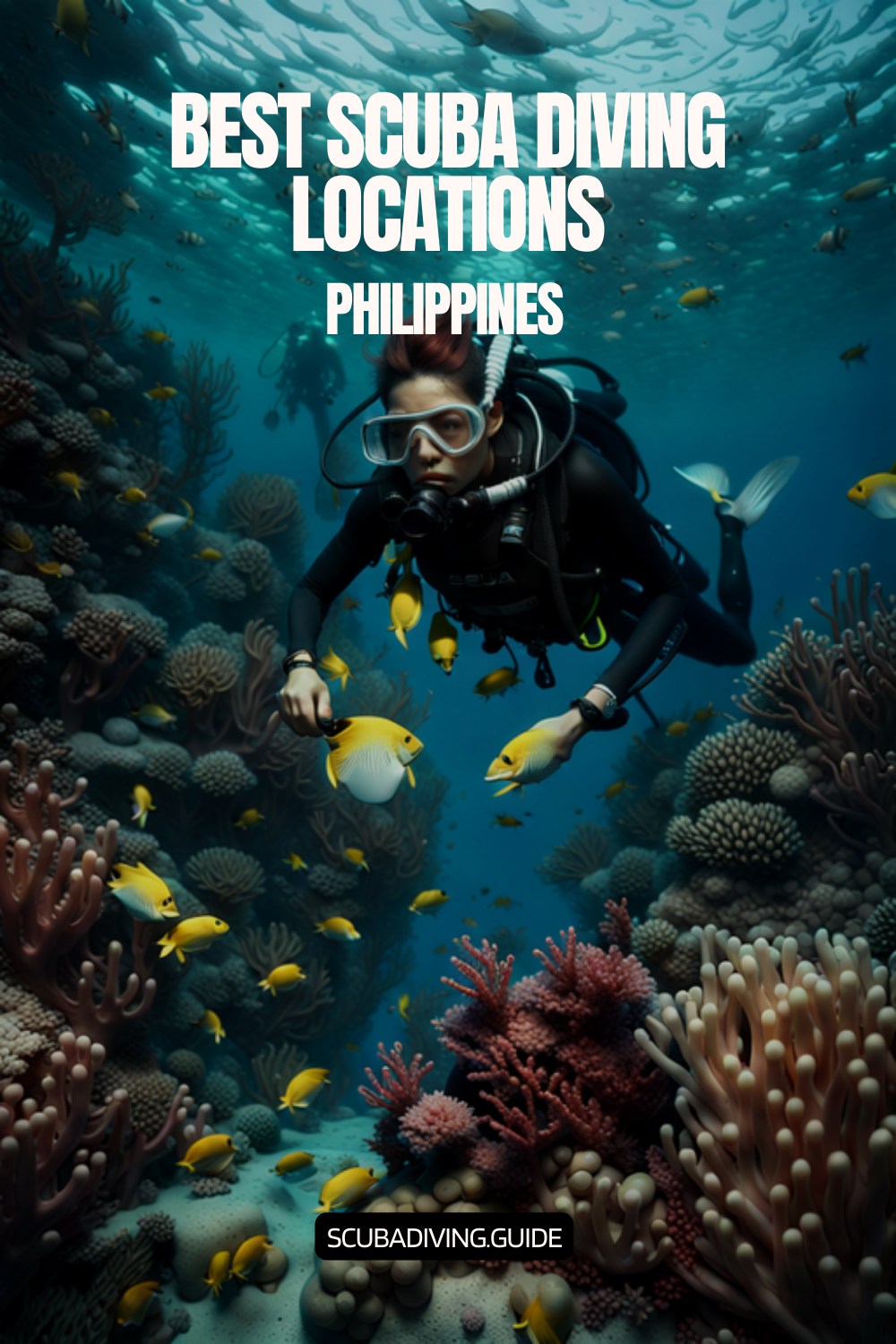
Introduction to Scuba Diving in The Philippines
The Philippines is a stunning place for scuba diving. It has an underwater world that amazes both new and seasoned divers. Located in the heart of the Coral Triangle, it has an incredible marine ecosystem. This promises unforgettable underwater adventures.
Why the Philippines is a Diver’s Paradise
Dive resorts in the Philippines give you access to a very biodiverse marine environment. With over 7,641 islands, it has a wide range of underwater landscapes and marine life. The Coral Triangle is home to:
- 2,000+ marine species
- 574 species of reef-building coral
- 1,400 species of reef fish
Best Times to Dive
The Philippines has optimal diving conditions all year round. Water temperatures are between 26°C to 30°C. The dry season from November to April is the best time to dive.
| Season | Diving Conditions | Marine Life Highlights |
|---|---|---|
| November-April | Excellent visibility | Peak marine activity |
| May-October | Potential rain | Unique seasonal species |
Popular Regions for Diving
Dive resorts are found in amazing locations that show off the Philippines’ marine diversity:
- Palawan – Wreck diving and coral gardens
- Cebu – Thresher shark encounters
- Bohol – Diverse marine ecosystems
- Moalboal – Famous sardine runs
“The Philippines offers an underwater world that transforms every dive into a magical exploration of marine life.” – Marine Enthuasiast Magazine
Top Diving Destinations in The Philippines
The Philippines is a top spot for diving, attracting divers from all over. With over 7,641 islands and 22,500 miles of coastline, it’s a paradise for underwater explorers. It offers dive tours for all skill levels.
Divers can see amazing marine life and unique underwater scenes. The Philippines is great for wreck diving and macro photography. It’s a place of unparalleled underwater adventures.
Tubbataha Reefs Natural Park
Tubbataha Reefs Natural Park is in the Sulu Sea and is a UNESCO World Heritage Site. It’s known for:
- Over 600 fish species
- 360 coral species (50% of global coral diversity)
- 11 shark species, including tiger and whale sharks
Diving season is from February to June, with visibility from 32 to 114 feet.
Apo Reef National Park
Apo Reef Natural Park is the Philippines’ largest atoll. It’s a marine sanctuary with:
- Approximately 400 recorded fish species
- Vibrant coral gardens
- Challenging dive sites like Apo 29
Anilao, Batangas
Anilao is just a 2-hour drive from Manila. It’s known for its muck diving. It offers:
- Incredible macro photography opportunities
- Beginner-friendly dive sites
- Year-round diving accessibility
“The Philippines is not just a destination, it’s an underwater world waiting to be explored.”
Whether you’re into wreck diving or want to see marine life up close, these places offer unforgettable dives.
Marine Biodiversity in The Philippines
The Philippines is a treasure trove of marine life. It has an underwater world that amazes divers and marine lovers everywhere. It’s known as the world’s center of marine biodiversity. Here, you can see nature’s most beautiful and detailed underwater scenes.
Unique Species to Observe
When you dive in Philippine waters, you’ll see amazing marine creatures. The country is home to a wide variety of marine species. You can see:
- Whale sharks over 12 meters long
- Thresher sharks with long, scythe-like tails
- Tiny pygmy seahorses smaller than a finger
- Rare harlequin shrimp loved by underwater photographers
- Five of the seven global turtle species
Coral Reefs and Ecosystems
The Philippines is in the Coral Triangle, a place with 76% of the world’s coral species. It has nearly 600 coral species and over 26,000 square kilometers of coral reefs. This underwater world is a key home for marine life.
| Marine Biodiversity Statistic | Number |
|---|---|
| Total Fish Species | 1,815 species (85% of global fish species) |
| Coral Species | 488 species |
| Mollusk Species | 5,000 species |
Conservation Efforts
Sustainable tourism is key to protecting these marine ecosystems. Divers can help by diving responsibly, supporting local marine protection, and spreading the word about marine conservation.
“The ocean is a vast, magical world waiting to be explored and protected.” – Marine Conservationist
Necessary Gear for Scuba Diving
Getting ready for an underwater adventure in the Philippines means picking the right gear. Scuba Diving in The Philippines needs specific equipment for safety and fun. It’s important for both newbies and seasoned Technical Diving fans to know their gear.
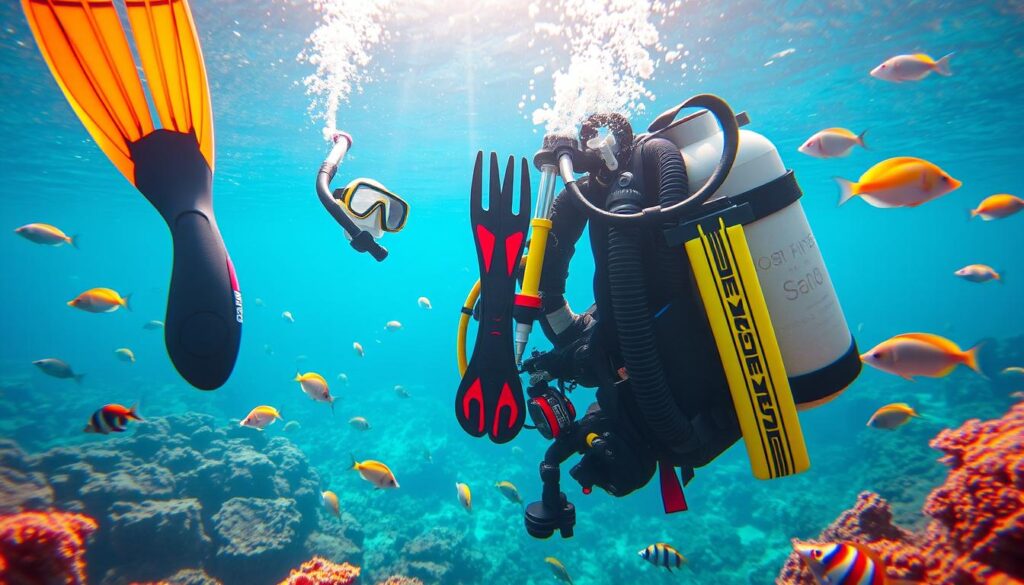
Essential Equipment for Beginners
For your first dive, you’ll need some basic stuff. In the Philippines, beginners should focus on these:
- Mask: Keeps your vision clear underwater
- Fins: Make swimming easier
- Wetsuit: Keeps you warm
- Weights: Helps you stay at the right depth
Advanced Gear for Experienced Divers
For those who dive deep, you’ll need better gear. Here’s what Technical Diving pros use:
- Dive computers: Monitor your dive
- Advanced regulators: Safe breathing at deep depths
- Specialized underwater cameras
- Emergency signaling devices
Rental vs. Buying Equipment
Many dive resorts in the Philippines let you rent gear. Here’s what to think about:
| Rental | Purchasing |
|---|---|
| Lower upfront cost | Long-term investment |
| Convenient for travelers | Personalized fit and comfort |
| No maintenance required | Consistent equipment familiarity |
“The right gear can transform your Scuba Diving in The Philippines from good to extraordinary.” – Professional Dive Instructor
Choosing the right diving equipment makes your underwater adventure better. It also keeps you safe during your dive in the Philippines.
Diving Courses Available
The Philippines has a wide range of dive certifications for all skill levels. From beginners to advanced technical divers, there’s something for everyone. You can find professional training options to suit your needs.
PADI Certification Levels
PADI offers dive certifications that build your skills step by step. The main certifications are:
- Discover Scuba Diving
- Open Water Diver
- Advanced Open Water
- Rescue Diver
- Divemaster
Discover Scuba Diving Experience
For those new to diving, the Discover Scuba Diving experience is perfect. It’s a short program that lasts 1-2 hours. It costs around Php 4,000, including gear and lunch.
“Dive into adventure with a safe, guided introduction to the underwater world!”
Advanced Open Water Training
For experienced divers, technical diving courses offer advanced skills. These programs teach complex diving techniques and how to use special equipment.
| Course | Duration | Cost (Php) |
|---|---|---|
| Open Water Diver | 3 days | 25,000 |
| Advanced Open Water | 2 days | 23,000 |
| Rescue Diver | Weekend | 22,000 |
| Discover Tec Diving | 1 day | 12,000 |
There are over 20 specialty courses, including Technical Diving programs. These courses challenge and improve your diving skills. Each certification brings you closer to mastering diving in the Philippines’ beautiful marine environments.
Safety Tips for Scuba Diving
Scuba diving in the Philippines is an amazing adventure. But, safety comes first. With over 295 dive sites, knowing safety rules is key for a great Dive Tours experience.
Most scuba diving accidents happen because of human mistakes. This shows how important training and being ready are.
Essential Diving Signals
Being able to talk underwater is vital for safety. Learn these basic hand signals to talk with your dive buddy:
- OK sign: Thumb and index finger forming a circle
- Problem/Help: Wave hand side to side
- Out of air: Slashing motion across throat
- Ascending/Descending: Thumb up or down
Managing Your Air Supply
Managing your air is key for safe diving. Not checking air can be dangerous, affecting 30% of divers.
| Air Supply Tip | Action |
|---|---|
| Start checking air at 50% | Begin planning return to surface |
| Reserve air | Maintain 500 PSI emergency supply |
| Use buddy system | Share air if needed |
Emergency Preparedness
Knowing how to handle emergencies is lifesaving. Always:
- Stay calm
- Signal your buddy
- Perform controlled ascent
- Follow emergency decompression protocols
“Preparation is the key to safe diving. Never dive beyond your training and always respect the ocean.” – Professional Diving Instructor
By following these safety tips, you’ll have a safe and fun scuba diving experience in the Philippines.
Environmental Considerations
Scuba diving lets us see marine ecosystems up close. But, we must explore responsibly to protect these underwater worlds. The Philippines leads in sustainable tourism, showing a strong commitment to its marine life.
Impact of Diving on Marine Life
Underwater activities can greatly affect marine ecosystems. Divers might accidentally harm these environments by:
- Improper fin kicks damaging coral structures
- Disturbing marine sediment habitats
- Potential stress to marine wildlife
- Unintended disruption of ecological balance
“Every dive is an opportunity to protect, not harm, our underwater world.”
Best Practices for Sustainable Diving
Responsible divers can reduce their impact by following these steps:
- Maintain perfect buoyancy control
- Avoid touching marine organisms
- Use reef-safe sunscreen
- Never remove marine life or artifacts
How to Participate in Conservation
Divers can help preserve marine life by:
- Joining underwater clean-up activities
- Supporting local marine protected areas
- Participating in citizen science projects
- Choosing eco-friendly dive operators
By adopting sustainable tourism, divers can safeguard the Philippines’ marine wonders for the future.
Liveaboard Diving Adventures
The Philippines is a top spot for dive lovers wanting to dive deep into the ocean. Liveaboard diving lets you explore remote sea spots. It turns regular dives into amazing journeys.
What to Expect on a Liveaboard
Liveaboard diving in the Philippines is a thrilling adventure. You’ll dive every day, stay in cozy cabins, and get expert guidance. You’ll see some of the most stunning underwater scenes in the world.
- Multiple daily dive sessions
- Professional dive guides
- Comfortable cabin accommodations
- Gourmet meals prepared onboard
Popular Liveaboard Cruises
The Philippines has many great dive spots. Tubbataha Reef is a top choice, known for its rich marine life. From March to June, you can see 11 shark species, including whale sharks.
“Tubbataha Reef offers an underwater paradise unlike any other destination in the world.” – Marine Exploration Magazine
Advantages of Liveaboard Diving
Liveaboard diving has special perks. You can dive in places you can’t reach by day trips. The Visayas region is full of wonders, like Malapascua’s thresher sharks.
| Destination | Unique Feature | Best Season |
|---|---|---|
| Tubbataha Reef | 11 Shark Species | March-June |
| Malapascua | Daily Thresher Shark Sightings | June-December |
| Coron Bay | World War II Wreck Diving | Year-round |
Whether you love wreck diving or vibrant coral reefs, the Philippines has it all. Prices range from 300 to 500 euros per night. It’s a unique way to explore the ocean.
Cultural Aspects of Diving in The Philippines
The Philippines is more than amazing underwater adventures. It has a rich maritime culture that connects deeply with the sea. Dive resorts across the islands are key to understanding this bond between local communities and the ocean.
Connection to Local Communities
Coastal communities in the Philippines have a special bond with the sea. Sustainable tourism helps keep this bond strong. Local people often work as:
- Dive guides
- Marine conservation experts
- Traditional boat operators
- Marine resource managers
Traditional Fishing Practices
Filipino fishing traditions show deep ocean knowledge passed down through generations. Many communities use sustainable fishing methods to protect the sea. These methods include:
- Selective fishing techniques
- Respect for marine breeding seasons
- Using traditional non-destructive fishing gear
Festivals Celebrating Marine Life
The Philippines has lively festivals that celebrate the sea. Notable ones include:
| Festival | Location | Marine Focus |
|---|---|---|
| Whale Shark Festival | Donsol | Whale Shark Conservation |
| Sardine Run Festival | Moalboal | Marine Biodiversity |
“Our ocean is our life, our culture, our future.” – Filipino Marine Conservationist
These cultural aspects turn diving into a deep dive into Philippine maritime heritage. It connects travelers with local ecosystems and communities.
Diving and Travel Logistics
Planning a scuba diving trip in the Philippines needs careful thought. With over 7,000 islands, it’s both exciting and challenging. This guide will help you plan your travel for amazing Dive Tours and Dive Resorts.
How to Get to Diving Spots
The Philippines has many entry points for divers. Manila and Cebu are the main airports for international flights. You can travel by:
- Domestic flights connecting major islands
- Ferry services between key diving destinations
- Boat transfers for remote dive locations
Recommended Accommodations
Dive Resorts in the Philippines fit all budgets and tastes. You can find everything from budget guesthouses to luxury beachfront resorts. These places are perfect for diving adventures.
| Location | Accommodation Type | Average Cost |
|---|---|---|
| Dumaguete | Luxury Beachfront Resort | $100-$250/night |
| Malapascua | Dive-Focused Lodging | $50-$150/night |
| Palawan | Eco-Friendly Resorts | $75-$200/night |
Local Transportation Tips
Getting between dive sites needs smart planning. Here are some tips:
- Use tricycles for short-distance travel
- Hire boats for island-hopping adventures
- Book organized Dive Tours for seamless transportation
“The secret to a great diving trip is flexible planning and local knowledge.” – Philippine Diving Expert
Pro tip: Always check seasonal weather patterns and possible travel disruptions, like the Sinulog festival in January, which might affect transportation.
Diving Conditions Throughout the Year
The Philippines is a paradise for scuba diving, with amazing marine life and changing underwater conditions. Knowing these changes helps divers plan their best dive in this beautiful archipelago.
Scuba diving in the Philippines offers unique experiences all year. Water temperatures and visibility vary, making each dive special.
Water Temperature and Visibility
Philippine waters are always warm, between 80 to 86 degrees Fahrenheit. Divers enjoy clear waters, often 50 to 70 feet deep.
- Warmest water temperatures occur in June
- Coolest temperatures experienced in February
- Average visibility ranges between 18-20 meters
Weather Patterns to Consider
The Philippines has two main seasons that affect diving:
- Dry Season (November to April)
- Calm seas
- Excellent diving visibility
- Ideal for underwater photography
- Wet Season (May to October)
- Potential reduced visibility
- More challenging diving conditions
- Unique marine life encounters
Seasonal Highlights
Each region in the Philippines has its own marine life highlights:
| Month | Location | Marine Life Highlight |
|---|---|---|
| January | Leyte | Hammerhead sharks, thresher sharks |
| March | Malapascua | Thresher shark sightings |
| May | Palawan | Whale shark migrations |
| September | Dumaguete | Calm seas, excellent visibility |
Pro tip: The best diving period in the Philippines is between December and May, with perfect weather and amazing marine life.
Photography and Filming Underwater
Underwater photography turns marine exploration into an art. It captures the stunning world beneath the waves. The Philippines is a great place for divers and photographers to see marine life up close.
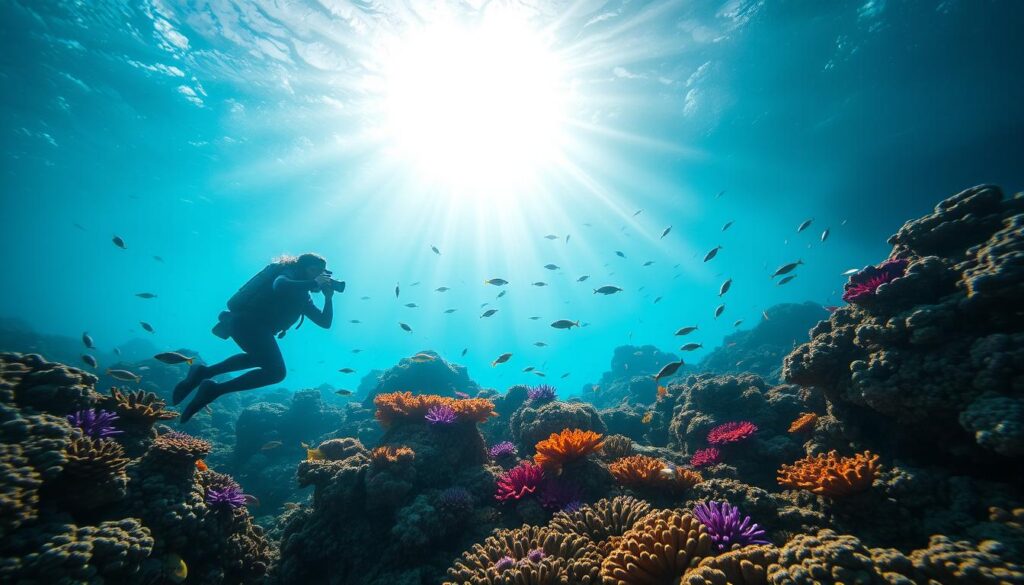
Tips for Capturing Marine Life
Mastering underwater photography needs special techniques. Good photographers know about lighting, composition, and how marine creatures move.
- Use natural light during shallow dives
- Get close to subjects without disturbing them
- Practice steady breathing to minimize camera shake
- Learn marine creature movement patterns
Recommended Cameras for Diving
Choosing the right camera is key for underwater photography. Different skill levels need different cameras.
| Camera Type | Skill Level | Price Range |
|---|---|---|
| Compact Waterproof | Beginner | $300-$500 |
| Mirrorless Camera | Intermediate | $1000-$2000 |
| Professional DSLR | Advanced | $3000-$5000 |
Editing Your Underwater Shots
Editing can make good underwater photos great. Coral reefs and marine life need careful color correction and adjustments.
“Underwater photography is about patience, technique, and understanding the marine environment.” – Professional Marine Photographer
Editing involves white balance correction, contrast enhancement, and color adjustments. Adobe Lightroom is great for making coral reefs and marine creatures pop.
With over 500 coral species and 2,500 fish species in Philippine waters, underwater photographers have a vast canvas to explore and document marine biodiversity.
The Philippines Recommended Scuba Diving Itinerary
Planning a scuba diving trip to the Philippines can be an exhilarating experience, given the country’s abundance of captivating dive sites. To make the most of your diving adventure, here’s a recommended scuba diving itinerary that encompasses some of the best diving locations in the Philippines:
Day 1-3: Manila and Anilao, Batangas
Start your journey in Manila, the capital city of the Philippines. After arriving at Ninoy Aquino International Airport, take some time to explore the city’s vibrant culture and historical sites. From Manila, make your way to Anilao, located in Batangas province, just a few hours’ drive away. Anilao is known as the birthplace of scuba diving in the Philippines and offers a plethora of dive sites for all levels. Spend a few days diving in Anilao’s pristine waters, exploring its diverse marine life and stunning underwater landscapes.
Day 4-6: Puerto Galera, Mindoro
Next, travel to Puerto Galera, located on the island of Mindoro. Puerto Galera is renowned for its stunning coral reefs and abundant marine life. Dive along the world-famous Verde Island Passage, known as the “Center of the Center of Marine Biodiversity.” Explore sites like the Canyons and the Giant Clams, which showcase vibrant coral gardens and the possibility of encounters with reef sharks and turtles. Puerto Galera also offers the opportunity to explore unique underwater caves and canyons, adding an element of adventure to your diving experience.
Day 7-9: Malapascua Island, Cebu
From Mindoro, make your way to Cebu and head to Malapascua Island. This small tropical paradise is famous for its encounters with thresher sharks at Monad Shoal. Witnessing these majestic creatures during their early morning rise is an unforgettable experience. Malapascua also offers beautiful wall dives, vibrant coral reefs, and the chance to spot other pelagic species such as manta rays and devil rays. Don’t miss exploring the diverse marine ecosystem of Gato Island, known for its underwater tunnels, caves, and marine sanctuaries.
Day 10-12: Moalboal and Pescador Island, Cebu
Continue your journey in Cebu and head to the picturesque town of Moalboal. Experience the thrill of the sardine run, where thousands of sardines move in mesmerizing unison. Dive along the Pescador Island Marine Park, known for its thriving coral reefs and encounters with turtles, reef sharks, and other marine species. Moalboal also offers stunning wall dives, beautiful coral gardens, and the chance to explore underwater canyons. Enjoy the vibrant marine life and the unique underwater landscapes this area has to offer.
Day 13-15: Tubbataha Reefs Natural Park, Palawan
Conclude your scuba diving adventure with a visit to Tubbataha Reefs Natural Park, a UNESCO World Heritage Site located in the Sulu Sea. Embark on a liveaboard trip to this remote marine sanctuary, known for its pristine coral reefs and staggering biodiversity. Explore the walls, atolls, and channels of Tubbataha North and Tubbataha South, encountering large pelagic species such as sharks, rays, and turtles. The sheer abundance of marine life in this area is awe-inspiring, making it a fitting finale to your diving itinerary.
Please note that this itinerary provides a general overview and can be customized based on your preferences, available time, and budget. The Philippines offers a wealth of additional diving destinations, such as Coron in Palawan, Dauin in Negros Oriental, and Balicasag Island in Bohol, which you may consider incorporating into your itinerary if time permits.
Remember to plan your trip during the optimal diving season for each location to ensure the best visibility and conditions. The Philippines’ diverse dive sites and breathtaking underwater landscapes promise a scuba diving experience like no other, creating lasting memories and a deep appreciation for the country’s natural beauty.
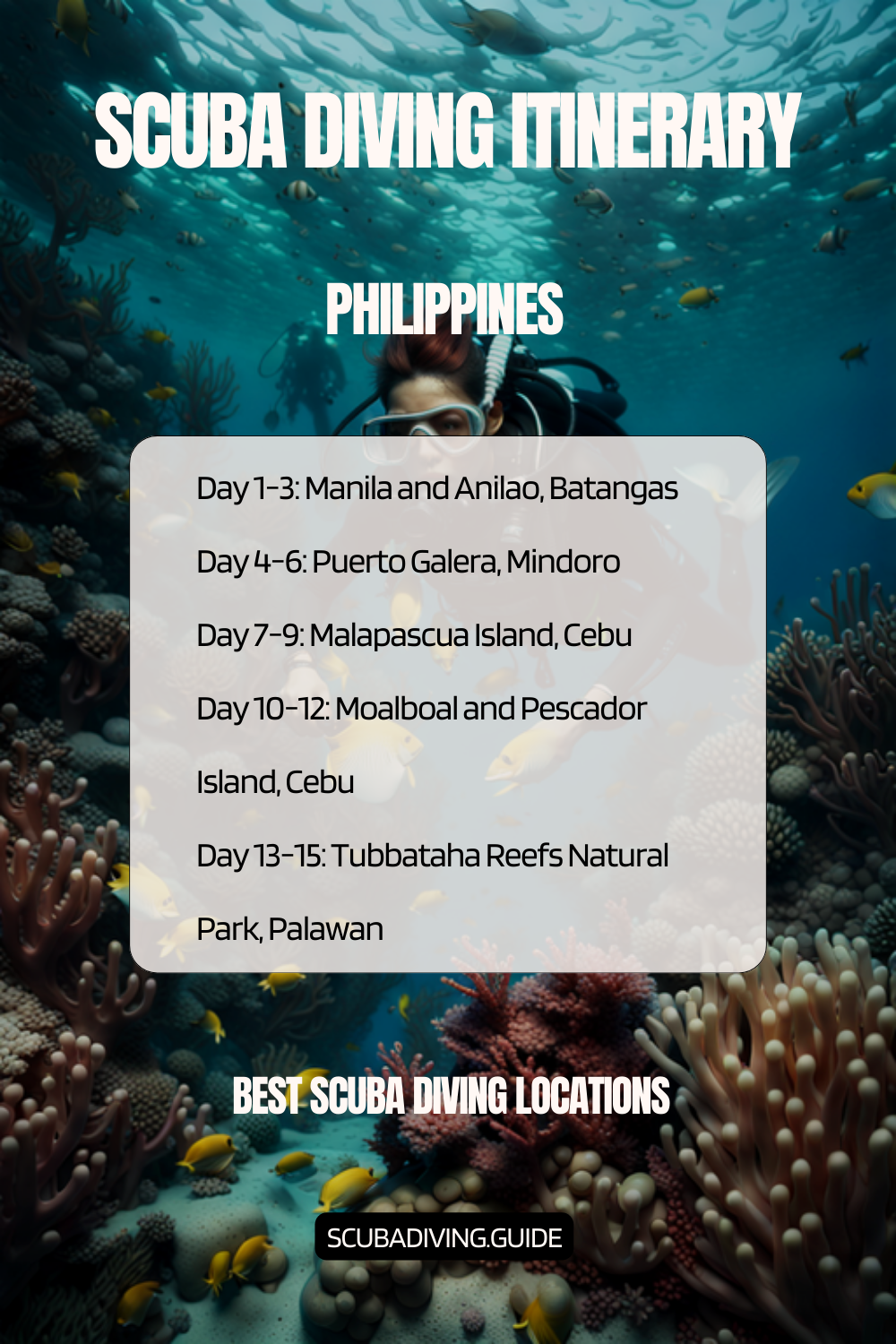
Other Countries to Consider
Conclusion
Scuba diving in the Philippines is an amazing journey through stunning marine environments. With over 7,000 islands and 76% of global coral species, it offers unique underwater experiences. Each dive site, from UNESCO World Heritage Tubbataha Reefs to Anilao’s vibrant ecosystems, shares a story of marine life.
Why You Should Dive in The Philippines
The Philippines’ waters are a paradise for underwater lovers. Sustainable tourism is key to keeping these ecosystems alive, home to over 2,000 reef fish species. Places like Apo Reef and Malapascua Island offer unforgettable encounters with marine life.
Final Thoughts on Your Diving Adventure
Your dive in the Philippines is more than fun—it’s a chance to connect with diverse marine life. By diving responsibly, you help protect coral reefs, which have lost nearly 50% of their coverage. Whether you’re new or experienced, the Philippines promises transformative dives that change your view of our underwater world.
FAQ – Scuba Diving in The Philippines
What are the best months for scuba diving in the Philippines?
The best diving months in the Philippines are from November to May. Peak season is between March and May. You’ll enjoy great visibility, calm seas, and perfect conditions for exploring the stunning marine ecosystems.
Do I need a special certification to dive in the Philippines?
Basic PADI Open Water certification is recommended. But, many dive centers offer Discover Scuba Diving for beginners. Advanced divers can dive at sites like Tubbataha Reefs with the right certifications.
What marine life can I expect to see while diving?
The Philippines is home to incredible marine life. You can see thresher sharks in Malapascua, whale sharks in Donsol, and pygmy seahorses in Anilao. Each dive site offers unique marine encounters.
How much does scuba diving cost in the Philippines?
Diving costs vary by location and experience. Single dives cost between $30 to $100. Package deals and multi-day trips are more affordable. Cebu and Bohol offer budget-friendly options.
Is underwater photography equipment necessary?
Underwater photography is not mandatory but many sites are great for it. Compact underwater cameras start at $300. Many dive resorts also offer rental equipment. Anilao is famous for macro photography.
What safety precautions should I take while diving?
Always dive with a certified guide. Check your gear, control your buoyancy, and monitor your air. Follow local safety protocols and know basic diving signals and emergency procedures.
Can beginners dive in the Philippines?
Yes! The Philippines has many beginner-friendly dive sites. Places like Boracay, Palawan, and parts of Cebu are great for learning and gaining confidence.
What equipment should I bring for diving?
Bring a mask, fins, and rash guard. Dive centers usually provide tanks, weights, and other gear. Consider a dive computer, underwater camera, and protection for tropical waters.
Are there eco-friendly diving options?
Yes, many Philippine dive operators focus on sustainable tourism. Look for those involved in marine protection, supporting local communities, and practicing responsible diving.
What are the visa requirements for diving in the Philippines?
Most tourists get a 30-day visa-free entry. Make sure your passport is valid for at least six months after your stay. Some nationalities need extra documents, so check with the Philippine embassy.
